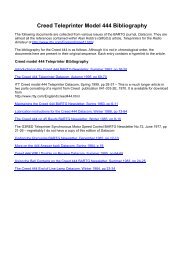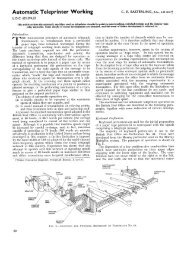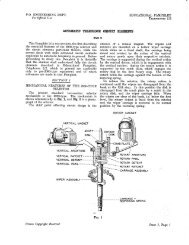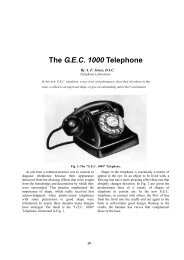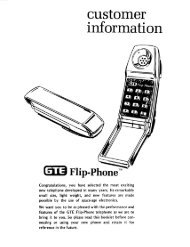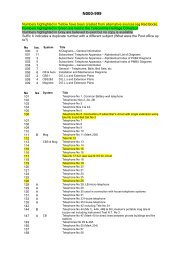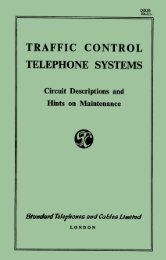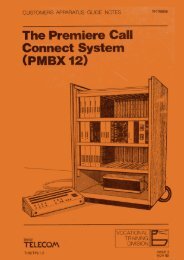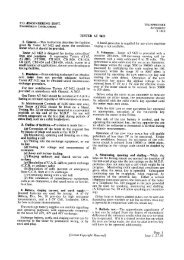Quadruplex Telegraphs & Repeaters - Sam Hallas
Quadruplex Telegraphs & Repeaters - Sam Hallas
Quadruplex Telegraphs & Repeaters - Sam Hallas
Create successful ePaper yourself
Turn your PDF publications into a flip-book with our unique Google optimized e-Paper software.
B.4<br />
Crown Copyright Reserved<br />
Post ost Of Office Of ice Engineering Engineering De Depar De par partment par tment<br />
TECHNICAL TECHNICAL P PPAMPHLETS<br />
P AMPHLETS<br />
FOR FOR WORKMEN ORKMEN<br />
Subject :<br />
P.W. - B.4<br />
Quadr Quadruple Quadr Quadruple<br />
uple uplex, uple x, Quadr Quadruple Quadr Quadruple<br />
uple uplex uplex<br />
x RR<br />
Repea RR<br />
pea peated pea ted<br />
Cir Cir Circuits Cir Cir cuits and and Tele ele elegraph ele ph R RRepea<br />
RR<br />
pea pea peater pea ter ters, ter<br />
Simplex Simplex and and Duplex.<br />
Duplex.<br />
ENGINEER-IN-CHIEF'S OFFICE.<br />
1919.<br />
(Reprinted Nov. 1930, inluding Correction Slips to date)<br />
( “ Jan. 1932, “ “ “ “ )<br />
( “ Mar. 1934, “ “ “ “ )<br />
LONDON<br />
PRINTED AND PUBLISHED BY HIS MAJESTY’S STATNIONERY OFFICE<br />
To be purchased directly from H.M. STATIONERY OFFICE at the following addresses :<br />
Adastral House, Kingsway, London, W.C.2; 120, George Sreet Edinburgh 2<br />
York Street, Manchester 1; St. Andrew’s Crescent, Cardiff;<br />
80 Chichester Street, Belfast;<br />
or through any Bookseller<br />
1936<br />
Price 6d. Net
LIST LIST LIST OF<br />
OF<br />
Tec ec ec echnical ec hnical PP<br />
Pamphlets PP<br />
amphlets f ffor<br />
f or Wor or orkmen. or kmen.<br />
GROUP A.<br />
1. Magnetism and Electricity.<br />
2. Primary Batteries.<br />
3. Technical Terms.<br />
4. Test Boards.<br />
5. Protective Fittings.<br />
6. Measuring and Testing Instruments.<br />
7. Sensitivity of Apparatus.<br />
8. Standard List of Terms and Definitions used in Telegraphy<br />
and Telephony. (Not on Sale)<br />
9. Standard Graphical Symbols for Telegraphy, Telephony and<br />
Radio Communication. (not on sale)<br />
GROUP B.<br />
1. Elementary Principles of Telegraphy and Syst ems up to Morse Duplex.<br />
2. Telegraph Concentrators.<br />
3. Wheatstone System. Morse Keyboard Perforators.<br />
4. <strong>Quadruplex</strong>, <strong>Quadruplex</strong> Repeated Circuits and Telegraph<br />
<strong>Repeaters</strong>, Simplex and Duplex.<br />
5. Hughes Type-printing Telegraph.<br />
6. Baudot Multiplex Type-printing System.<br />
7. Western Electric Duplex Multiplex. Murray Duplex<br />
Multiplex. Siemens and Halske Automatic Type-printing System.<br />
8. Fire Alarm Systems.<br />
GROUP C.<br />
1. Wireless Transmission and Reception.<br />
2. Interference with Reception of Broadcasting.<br />
GROUP D.<br />
1. Elementary Principles of Telephony.<br />
2. Telephone Transmission. "Loading." Telephone <strong>Repeaters</strong> and Thermionic Valves.<br />
3. Principles of Telephone Exchange Signalling.<br />
4. Magneto Exchanges - Non-Multiple Type.<br />
5. Magneto Exchanges-Multiple Type.<br />
6. C.B.S. No. 1 Exchanges-Non-Multiple Type.<br />
7. C.B.S. Exchanges-Multiple Type.<br />
8. C.B. Exchanges-No. 9 Type.<br />
9. C.B. Exchanges-No. 10 Type.<br />
10. C.B. Exchanges-No. 12 Type.<br />
11. C.B. Exchanges-22 Volts.<br />
12. C.B. Exchanges-40 Volts.<br />
13. Trunk Telephone Exchanges.<br />
14. Maintenance of Manual Telephone Exchanges.<br />
15. Telephone Testing Equipment.<br />
16. Routine Testing for Manual Telephone Exchanges.<br />
17. Internal Cabling and Wiring.<br />
[Continued on page iii of Cover.
FOR OFFICIAL USE<br />
<strong>Quadruplex</strong>, <strong>Quadruplex</strong> Repeated Circuits<br />
and Telegraph <strong>Repeaters</strong>, Simplex and<br />
Duplex.<br />
(B.4).<br />
The following pamphlets in this series are of<br />
kindred interest:<br />
A.1. Magnetism and Electricity<br />
B.1. Elementary Principles of Telegraphy and Systems up to<br />
Morse Duplex.<br />
B.3. Wheatstone System. Morse Keyboard perforators<br />
(33770)
1<br />
CORRECTION SLIP TABLE<br />
The month and year of issue is printed at the end of each<br />
amendment in the Correction Slips, and the number of the slip<br />
in which any particular amendment is issued can, therefore, be<br />
traced from the date. In the case. of short corrections made in<br />
manuscript, the date of issue of the slip should be noted against<br />
the correction.<br />
The Summary portions of the Correction Slips should be<br />
completed and affixed below in numerical order.
2<br />
CORRECTION SLIP TABLE - (contd.)<br />
The month and year of issue is printed at the end of each<br />
amendment in the Correction Slips, and the number of the slip<br />
in which any particular amendment is issued can, therefore, be<br />
traced from the date. In the case. of short corrections made in<br />
manuscript, the date of issue of the slip should be noted against<br />
the correction.<br />
The Summary portions of the Correction Slips should be<br />
completed and affixed below in numerical order.
3<br />
<strong>Quadruplex</strong>, <strong>Quadruplex</strong> Repeated<br />
Circuits and Telegraph <strong>Repeaters</strong>,<br />
Simplex and Duplex.<br />
TABLE OF CONTENTS.<br />
Section A : <strong>Quadruplex</strong> PAGE<br />
1. MORSE QUADRUPLEX ... ... ... ... ... 5<br />
2. QUADRUPLEX A SIDE, RELAYED SIMPLEX. (Morse<br />
<strong>Quadruplex</strong> A Side extended to C.B. Simplex<br />
line) ... ... ... ... ... ... 7<br />
3. QUADRUPLEX A SIDE, RELAYED DUPLEX. (Morse<br />
<strong>Quadruplex</strong> A Side extended to Duplex Circuit) ... 9<br />
4. SPLIT QUADRUPLEX REPEATER. (Morse <strong>Quadruplex</strong><br />
A Side extended to A side of another <strong>Quadruplex</strong>) 10<br />
5. FORKED QUADRUPLEX REPEATER. (Morse <strong>Quadruplex</strong>,<br />
A & B extended to two separate Duplex Circuits) 11<br />
6. WHEATSTONE WORKING ON THE A-SIDE WITH<br />
VIBRATING RELAY, STANDARD G ... ... ... 14<br />
Section B : Telegraph <strong>Repeaters</strong>, Simplex and Duplex.<br />
1. REASONS FOR USE OF REPEATERS ... ... ... ... 17<br />
2. ARRANGEMENT OF APPARATUS ... ... ... ... 17<br />
3. DUPLEX AND SIMPLEX REPEATERS ... ... ... ... 17<br />
4. AUTOMATIC SWITCHES ... ... ... ...6 ... 17<br />
5. PATHS OF CURRENTS THROUGH REPEATERS WHEN AT<br />
SIMPLEX ... ... ... ... ... ... 18<br />
6. LEAK CIRCUITS FOR SIMPLEX WORKING... ... ... 21<br />
7. DUPLEX CONNECTIONS ... ... ... ... ... 21<br />
8. LEAK CIRCUITS FOR DUPLEX WORKING ... ... ... 22<br />
9. FORKED REPEATERS ... ... ... ... ... 23
4<br />
Fig. 1.<br />
Fig. 2.
5<br />
SECTION “A” : QUADRUPLEX<br />
1. MORSE QUADRUPLEX.<br />
Fig. 1 shows diagrammatically a line wire connected at each end to<br />
<strong>Quadruplex</strong> apparatus. P represents a Relay Standard B, the tongue of which<br />
closes the local circuit when a positive current flows in the direction from U<br />
to D or from (U)to (D)<br />
From a scrutiny of the diagram, it will be apparent that if the B key remains<br />
at rest, that is, with the connections as shown in Fig. 1, and if the nonpolarised<br />
relay NP be short-circuited, then the remaining circuit arrangement<br />
is a simple differential duplex set. Of the two coils of each Relay Standard B,<br />
one will be associated with the line circuit and the other with the compensation<br />
circuit. When, therefore, currents are flowing in both coils, the local<br />
circuit will be closed only when the difference between the two currents is<br />
such that the preponderance of one over the other results in a positive current<br />
either in the direction from U to D or from (U) to (D). In the case of the Relay<br />
Standard B, the strength of the current does not affect the local circuit; it is<br />
the direction of the preponderating current that determines the receipt of a<br />
signal.<br />
The relay marked NP in Fig. 1 is a non-polarised relay. That is to say, the<br />
tongue will close the local circuit when currents, either positive or negative,<br />
are passed through the coils. The relay (with the coils joined in series) is<br />
connected to the terminals (D) and (U) of the Relay Standard B, and currents<br />
flowing through the latter will also flow through the non-polarised relay. If<br />
both relays are adjusted so as to respond to, say, 10 m.a. of current and signals<br />
are being sent, then relay P will respond only to the preponderating<br />
marking currents, whilst the local circuit of relay NP will remain permanently<br />
closed. The adjustments of the relay NP are such that by means of a<br />
spiral spring the tongue may be prevented from responding to the magnetic<br />
effect of currents passing through the coils. The extent to which this may be<br />
done is limited. Thus, in the case of a Relay NPC 100+100 ohms, the full<br />
tension of the spring will prevent the tongue responding to currents equivalent<br />
to that of values of less than 28 m.a. passing through one of the coils.<br />
Suppose the relays are adjusted so that relay P responds to a current of 10<br />
m.a. and relay NP responds to currents greater than 28 m.a., then <strong>Quadruplex</strong><br />
working will be possible if the currents in the NP relay can be increased<br />
under the control of a separate key without affecting the apparatus at the<br />
sending end. From Fig. 1 it will be seen that the currents from the A side key<br />
pass through both the P and the NP relays differentially, and therefore the<br />
resultant magnetic effect on the armatures is nil. That is to say, the outgoing<br />
(33770) B*
6<br />
currents do not affect the tongues of the relays. If, therefore, the connections<br />
between the battery and the A side key are made through the B key (Fig. 1),<br />
the desired result will be accomplished. That is to say, the relays P respond to<br />
positive currents in the direction U to D or (U) to (D) , while the relays NP<br />
respond only to currents of a strength greater than that sent by the A side key.<br />
The figure of merit tests provide for the P relays being adjusted to respond<br />
to currents as low as ½ m.a. In practice the NP relays are adjusted by<br />
means of the spiral spring to respond to currents of about 3 times the value of<br />
those due to the A-side key<br />
The actual adjustments will depend upon the nature of the line wire.<br />
Where leakage is present, it may happen that only about 5 m.a. are received<br />
from the distant A side key and 15 m.a. from the B side key, in which<br />
case it will be necessary to adjust the tension on the spiral spring of the B<br />
relay, so that the smaller B side current may effectively close the local circuit.<br />
The usual currents employed are 10 to 15 m.a. on the A side and 30 to 45<br />
m.a. on the B side. The corresponding Galvanometer deflections are 30 to 35<br />
divisions and 55 to 63 divisions respectively.<br />
The need for careful adjustment of the A side key will be evident in considering<br />
the conditions when the distant B key is depressed for the duration<br />
of a dash while the A side key is sending dots. The A side key reverses the<br />
polarity of the battery, and if the adjustment of the key contacts is not sufficiently<br />
exact, the reversal of the magnetism in the coils of the non-polarised<br />
relay due to the reversals of polarity under the control of the sending A key is<br />
apt to permit of the momentary release of the armature. When such release<br />
occurs, the defect known as Split B side signals is encountered. The defect is<br />
also caused by high line capacity or low insulation resistance.<br />
The tendency to split the B side signals cannot be entirely got rid of, but<br />
the arrangements shown in Fig. 2 partly compensate for this defect in<br />
quadruplex working.<br />
In Fig. 2, R1 is an adjustable resistance coil (100+ 200 + 400 ohms) and<br />
R2 is a fixed resistance of 50 ohms. When a momentary break occurs in the<br />
circuit at the contact points of the relay, the condenser discharges itself through<br />
the sounder and the resistance R1. This discharge, together with the inductive<br />
effect produced by the coils of the sounder (which is such as to prolong<br />
the current beyond the instant when the circuit is broken), causes the magnetism<br />
to be retained in the cores of the sounder for a time sufficient to bridge<br />
the momentary disconnection.<br />
With the ordinary quadruplex working a sounder is connected to the local<br />
contacts of the A side relay.
7<br />
2. MORSE QUADRUPLEX A SIDE EXTENDED TO CB<br />
SIMPLEX.<br />
In the simplest form of <strong>Quadruplex</strong> Repeater the local sounder on the A<br />
side relay is replaced by a Central Battery circuit. The arrangement is shown<br />
in Fig. 3, from which it will be seen that the line wire of the Central Battery<br />
Circuit is connected to the tongue of the A side Relay Standard B, and the<br />
Central Battery voltage is fed through a Relaying Sounder Polarised to the<br />
spacing contact of the A side relay, there being a feed resistance of 1,000<br />
ohms in circuit with the battery.<br />
When the Central Battery out-office key is depressed the line is earthed<br />
and the current from the 80 volts battery energises the Polarised Relaying<br />
Sounder, of which the spacing and marking contacts of the locals are “teed”<br />
Fig. 3.<br />
on to the battery terminals of the A side key of the <strong>Quadruplex</strong> set, whilst the<br />
tongue is connected to the middle top terminal of the A key. This will be clear<br />
from Fig. 3.<br />
If, therefore, the A side key be put to “Receive,” the tongue of the Polarised<br />
Relaying Sounder will be connected to the “Split” of the NP Relay and<br />
to the <strong>Quadruplex</strong> line.<br />
When the Polarised Relaying Sounder is energised, the movement of the<br />
tongue from the spacing to the marking contact reverses the battery polarity<br />
on the <strong>Quadruplex</strong> line. The out office on the Central Battery circuit can by<br />
this means signal to the operator on the A side of the quadruplex at the distant<br />
station.<br />
The method of signalling from the distant station operator to the Central<br />
Battery line will be apparent from a glance at Fig. 3. Normally, all the con-
8<br />
densers on the C.B. line are charged. The marking contact of the A side Relay<br />
Standard B is connected to earth. Each time the tongue is attracted to the<br />
marking stop, all the condensers on the C.B.S. line discharge through their<br />
respective Polarised Sounders.<br />
The Polarised Relaying Sounder is connected to the spacing contact of<br />
the A side Relay Std. B, and therefore is disconnected when the tongue of the<br />
relay passes from the spacing contact to the earthed marking stop. The reason<br />
for this will be evident when it is remembered that the function of the Polarised<br />
Relaying Sounder is to take the place of the A key. That is to say, it is the<br />
equivalent of the A key worked under the control of the distant C.B. apparatus.<br />
If, therefore the movement of the tongue of the A side Relay did not<br />
effect the disconnection of the Sounder Relaying Polarised at the spacing<br />
Fig. 4.<br />
contact, the distant UP station operator would receive back, on the A side<br />
Sounder, signals sent by him on the A side key. The closest possible adjustment<br />
of the Sounder Relaying key is necessary in order to avoid the defect of<br />
Split B signals on the <strong>Quadruplex</strong> side occurring. Even with the best adjustment<br />
attainable the results cannot be so good as that obtained with a closely<br />
adjusted Key D.C. with adjustable contacts, by means of which a momentary<br />
short-circuit is given in the intermediate position of the key lever.<br />
The reason for the use of two sounders Polarised on the C.B.S. line at the<br />
repeating office will now be clear; that on the local of the Polarised Relaying<br />
Sounder gives an indication that the signals from the C.B. line are being<br />
repeated to the Quad. line, whilst that on the Galvanometer of the C.B. line<br />
shows whether or not the A side <strong>Quadruplex</strong> signals are passing correctly to<br />
the C.B. system.<br />
The service provided by this type of <strong>Quadruplex</strong> Repeater is represented<br />
by the symbols shown in Figure 4.
9<br />
3. QUADRUPLEX A SIDE RELAYED DUPLEX.<br />
The second type of <strong>Quadruplex</strong> Repeater to be described is that known<br />
as <strong>Quadruplex</strong> A side relayed Duplex. The arrangement is symbolised in Fig.<br />
Fig. 5.<br />
5 and the theoretical connections are shown in Fig. 6.<br />
Fig. 6.<br />
From what has been said regarding the <strong>Quadruplex</strong> A side relayed C.B.S.,<br />
no difficulty will be experienced in understanding the principle. From Fig. 6<br />
it will be seen the tongue of the A side Relay Standard B is extended to an
10<br />
ordinary double current duplex set. The battery of the duplex set is connected<br />
to the spacing and marking contacts of the A side relay. With the key of the<br />
duplex set at “Receive” the tongue of the A side relay is connected to the split<br />
of the relay on the duplex set.<br />
The battery on the duplex circuit is therefore controlled by the movement<br />
of the tongue of the A side relay, so that the distant station x <strong>Quadruplex</strong><br />
operator can transmit signals to the distant station c on the duplex line.<br />
Working in the other direction, it will be seen the arrangements are similar.<br />
The locals of the duplex circuit relay are “teed” to the A key (Fig. 6) and<br />
with the latter at “Receive” the tongue of the duplex relay is joined through<br />
Fig. 7.<br />
to the <strong>Quadruplex</strong> line. Thus the A side <strong>Quadruplex</strong> battery is controlled by<br />
the movement of the tongue of the relay on the duplex circuit. Leak relays,<br />
connected to the tongues of the transmitting relays, are provided for the purpose<br />
of observing whether the signals are passing satisfactorily in both directions.<br />
4. SPLIT QUADRUPLEX REPEATER.<br />
The third <strong>Quadruplex</strong> Repeater to be described is that designated as “Split<br />
<strong>Quadruplex</strong> Repeater.” Fig. 7 shows that three duplex circuits are provided<br />
by means of the arrangement, viz., one duplex circuit between the repeating<br />
office and each of the terminal offices, and one duplex between the terminal<br />
offices. The latter circuit is obtained by relaying the A side.<br />
Fig. 8 shows the repeating office connections in skeleton form.<br />
Two full <strong>Quadruplex</strong> sets are placed side by side. The A side signals are<br />
repeated from one terminal station to the other by means of the tongues of the<br />
polarised relays connected to the A side keys as shown in the figure. At the A<br />
keys, the currents from the batteries at the repeating station are picked up by<br />
the tongues of the A relays.<br />
When the B keys are worked they augment the currents which are being<br />
sent out by the A relays, thus the repeating station can work independently on
11<br />
the B sides to stations X and Y while the two latter stations are in direct<br />
communication on the A side.<br />
Fig. 8.<br />
5. - FORKED QUADRUPLEX REPEATER.<br />
The fourth and last <strong>Quadruplex</strong> Repeater to be described is that known<br />
Fig. 9.<br />
as “Forked <strong>Quadruplex</strong> Repeater,” which is represented symbolically in Fig.<br />
9. By this arrangement both A and B sides of the <strong>Quadruplex</strong> are relayed at y,<br />
so that with one <strong>Quadruplex</strong> set at x, duplex circuits to the two offices c and<br />
d are obtained.
12<br />
The skeleton connections are shown in Fig. 10.<br />
At the repeating office y the circuits connected to the terminal stations 1<br />
and 2 (see Fig. 10) on the forked wires are terminated on duplex apparatus.<br />
The terminal station 3 on the main line (which is in communication with<br />
station 1 on the A side and with station 2 on the B side) is worked from a<br />
<strong>Quadruplex</strong> set.<br />
When station 1 signals to station 3 the path of the currents is as follows:-<br />
From line 1 to the D terminal of relay R1 to the split of the relay, from which<br />
a negligible portion of the current passes to earth through a resistance shunted<br />
by a condenser connected to the terminal U of the relay; most of the current,<br />
however, passes from the split of the relay through K1 to the tongue and M or<br />
S terminal of relay R3, battery terminal of key K1 to battery B3 and earth.<br />
The tongue of the relay R1 is actuated and transmits positive or negative<br />
currents according to which of the contact stops it touches, to the split of the<br />
non-polarised relay R4 (through K4). At this point the currents divide, one<br />
portion passing through one half of the coils of relays R4 and R3, thence to<br />
station 3, the other portion going through the other coils of the relays R4 and<br />
R3, a resistance coil shunted by a condenser and the non-polarised “Observation”<br />
relay R6 to earth.<br />
The currents due to the signals made when station 2 signals to station 3<br />
pass through the apparatus at the repeating station as follows:-<br />
From station 2 line to terminal D of relay R2, key K2, tongue of relay R3<br />
and battery B4. Relay R2 is actuated and completes a circuit through the key<br />
K3 and two polarised relays, R7 and R8 (termed “incrementing relays”) joined<br />
up in series with each other and a resistance coil r3 (1,500 ohms).<br />
These incrementing relays are so adjusted that they act together as one<br />
instrument and perform the same function as a hand operated B-side key.<br />
(The armatures should be set neutral and each tongue should have the same<br />
amount of play.)<br />
The tongues of these relays are connected to the A side key K4, and to the<br />
contact stops of the polarised relay R1 and the tongue of the latter relay sends<br />
out current to station 3, which is derived from the small (A side) Battery B2,<br />
or large (B side) battery, according to whether the tongues of the incrementing<br />
relays are touching their spacing or marking stops. The movements of the<br />
tongue of the polarised relay R2 therefore determine whether the B side nonpolarised<br />
relay at station 3 shall be actuated or not.<br />
Signals from station 3 for station 1 actuate the polarised relay R3, the<br />
tongue of which picks up positive or negative currents from its contact stops<br />
(which are teed to K1, to which a separate battery B3 is joined), and sends<br />
them out to station 1.
13<br />
On the B side, station 3, in communicating with station 2, actuates the<br />
non-polarised relay R4, the tongue of which, when it moves to the marking<br />
stop, closes a circuit having a separate battery, B5, and the polarised transmitting<br />
relay R5. (This relay is joined in series with 50 ohms and 500 ohms<br />
coils, and is shunted by a condenser 8 mf. The arrangement is similar, and<br />
has a similar purpose, to that used for the prevention of the B side “kick.”)<br />
The tongue of the transmitting relay picks up positive and negative currents<br />
Fig. 10.<br />
from its contact stops, which are teed to the key K2, the key being joined to<br />
a separate divided battery B4, and transmits these currents to station 2 in<br />
accordance with ordinary duplex methods.<br />
As in the case of the A side relayed duplex arrangement, leak circuits are<br />
provided for observation purposes. They are connected to the tongues of the<br />
polarised relays R1, R3, R5.<br />
A non-polarised relay, R6, is inserted in the compensation circuit of the<br />
quadruplex set in order that the repeated B side signals may be kept under<br />
observation. Only one coil of this relay is used, and this is shunted by a<br />
resistance of 300 ohms to reduce its sensitiveness. In this way it is ensured<br />
that the relay is operated only when good signals are being sent out by the<br />
incrementing relays.
14<br />
6. - WHEATSTONE WORKING ON THE A-SIDE WITH<br />
VIBRATING RELAY, STANDARD G.<br />
In one of the circuit arrangements an incrementing voltage which usually<br />
consists of a 30-volt battery is added both to the A and the B batteries.<br />
Assuming an A voltage of 40 and a B voltage of 120, the following ratios<br />
will obtain with key and Wheatstone working respectively, viz. -<br />
Key working = B voltage = 120 = 3<br />
A voltage 40<br />
Wheatstone working = B = 120 + 30 = 2 1/7.<br />
A 40 + 30<br />
In this case the reduction of the ratio B/A from 3 to 2 1/7 although not<br />
advantageous from the point of view of B-side working, tends to improve the<br />
Wheatstone signals.<br />
In another wiring arrangement, the incrementing voltage is added to the<br />
B-side battery by the energising of an electromagnetic switch at the moment<br />
when the switch lever of the Wheatstone transmitter is turned on. The ratios<br />
B/A obtained under the two conditions previously mentioned are in this instance<br />
as .follows, viz. :<br />
Key working B/A = 3.<br />
Wheatstone working B/A = 120 + 30 = 3.75<br />
40 + 30<br />
The increased ratio of B/A = 3.75 tends to maintain good working on the<br />
B-side when the transmitter is started on the A-side. There are, however,<br />
circuit conditions under which difficulty is experienced in obtaining good<br />
wheatstone working.<br />
From the foregoing considerations, and also having regard to the fact<br />
that the circuit conditions referred to involve the use of voltages in excess of<br />
120, it was decided to dispense with the use of incrementing voltages; and<br />
with the object of improving the working conditions for Morse <strong>Quadruplex</strong>,<br />
the wiring shown in Fig. 11 was adopted.<br />
Where the line conditions are not too exacting it will be possible to obtain<br />
good Wheatstone working at 100 words per minute with voltages of 24<br />
on the A-side and 80 on the B-side, by means of the vibrating relay, Standard<br />
G, wired as shown in the diagram. In other cases 40 and 120 volts can be<br />
used.<br />
The main difficulty experienced with this type of installation is interference<br />
with the B-side signals caused by momentary out-of-balance conditions
16<br />
of the circuit due to disconnections produced at the moment when the transmitter<br />
switch lever is turned and when the transmitter contact lever crosses<br />
from one side to the other between the contact stops. It is, therefore, advantageous<br />
that the transmitter starting lever be turned quickly and that the transit<br />
time of the contact lever be made as short as possible by ensuring that the<br />
contact screws are adjusted as closely as practicable without incurring the<br />
danger of short circuiting.<br />
With a Wheatstone transmitter accurately and closely adjusted the increase<br />
in resistance in the circuit due to the motion of the contact lever between<br />
the contact stops should be not greatly in excess of 40 ohms.<br />
Provision is made for balancing this resistance by means of a Coil, Retardation,<br />
10-plug, having a resistance range from 1 ohm to 320 ohms. The<br />
function of the coil is briefly as follows:- With no resistance in the coils at<br />
each end an approximate balance is obtained to the distant station who is<br />
then requested to give “R” and at the same time run his transmitter. When<br />
capacity and resistance balances have been obtained the distant station should<br />
be asked to give “R” without running the transmitter. The circuit will now be<br />
out of balance and the distant station should be asked to insert resistance in<br />
the Coil Retardation 10-plug until the balance is again good.
17<br />
SECTION "B" : TELEGRAPH REPEATERS, SIMPLEX AND<br />
DUPLEX.<br />
1. REASONS FOR THE USE OF REPEATERS.<br />
By the insertion of a Repeater on a long Telegraph line the speed and<br />
reliability of working is greatly improved. Its introduction into a circuit divides<br />
the line into two distinct sections, and the speed of working is increased<br />
practically to that of the longer or more difficult of the two sections.<br />
2. ARRANGEMENT OF APPARATUS.<br />
The repeating apparatus is so arranged that the currents from the terminal<br />
stations complete their paths through the relays at the repeating office, and,<br />
as a result of the actuation of the relays, fresh currents are sent out front the<br />
repeating office to the distant stations.<br />
3. DUPLEX AND SIMPLEX REPEATERS.<br />
The combined “Duplex and Simplex” form of Repeater is now the standard<br />
type. The connections of the instruments are so arranged that either Duplex<br />
or Simplex working between the terminals may be readily provided for<br />
at the repeater office. For Duplex working some boards are fitted on the<br />
differential principle on both sides, other boards are arranged for differential<br />
duplex on one side and for bridge duplex on the other. The latest development<br />
is arranged for “Universal” working, that is, to receive and send negative<br />
currents for marking, and positive currents for spacing on both sides,<br />
and also with either differential or bridge duplex conditions available on<br />
both sides.<br />
Figure 1 gives the simplex connections on a board arranged for differential<br />
duplex on the “Up” side, and for bridge duplex on the “Down” side.<br />
P.O. Standard B Relays are generally used for transmitting purposes.<br />
The neutral Relays are the P.O. Standard neutral B type.<br />
The two keys are “Keys S.C. with Switch,” and these are provided to<br />
allow the repeater clerk to communicate with the terminal offices.<br />
4. AUTOMATIC SWITCHES.<br />
It is necessary to provide means by which the functions of the Switch of<br />
the Double current key at the terminal offices can be carried out automatically<br />
on the repeater board. For this purpose two automatic switches, or,<br />
more properly, Switches Electro-Magnetic, are provided.<br />
It will be seen from Figure 1 that the local circuit through the auto-switches<br />
is normally disconnected, owing to the central position of the controlling<br />
relay tongue, but it is completed when currents pass through the relay and
18<br />
cause the tongue to move over to the S or M contact. The coils of the Autoswitches<br />
are provided with a shunt which renders them sluggish in action, so<br />
that they remain closed during the momentary disconnection when the tongue<br />
of the relay passes over from one contact to another. In the diagram the levers<br />
of the “Up” auto-switch are shown in the position they occupy when the<br />
“Up” neutral relay is actuated by the incoming current.<br />
5. PATHS OF CURRENTS THROUGH THE<br />
REPEATERS WHEN AT SIMPLEX.<br />
Tracing now the path of an incoming positive current from the “Up”<br />
station, i.e., a " marking " current, it will be seen that the current passes<br />
through one coil of the “Up” galvanometer, across the “Up” key, to the righthand<br />
lever of the “Down” auto-switch, then in a " marking " direction through<br />
the “Up” transmitting relay, through the rheostat, and “Up” neutral relay to<br />
earth. As already explained, the “Up” neutral relay has closed the “Up” autoswitch,<br />
and, as the tongue of the “Up” transmitting relay is now against the<br />
contact M, a positive current will pass from the<br />
“Up” main battery via the tongue of the “Up” transmitting relay to the<br />
“Up” auto-switch, and by the right-hand side lever across the “Down” key,<br />
through one coil of the “Down” galvanometer, and so on to the distant “Down”<br />
station.<br />
With the reversal of the “Up” station’s current, it will be readily followed<br />
that the “Up” auto-switch will remain closed, and as the “Up” transmitting<br />
relay tongue will then be against the contact on the spacing side, a current in<br />
the reverse direction will be sent out from the “Up” main battery.<br />
It should be clearly understood that the “Up” main battery sends current<br />
to the “Down” station, and that the “Down” main battery works to the “Up”<br />
station.<br />
The “Up” rheostat and condenser for the duplex balance are available for<br />
use in fast-speed simplex working, as the rheostat is arranged as a shunt<br />
across the condenser.<br />
In receiving from the “Down” station, the paths of the spacing and marking<br />
currents can be similarly traced. It will be noticed that the “Down” main<br />
batteries are reversed as compared with the “Up” main batteries to meet the<br />
condition that a “Down” office sends out a negative current for marking and<br />
a positive current for spacing.<br />
The “Down” station's current passes through the Reading condenser and<br />
shunt, in addition to passing through the rheostat and condenser, for the duplex<br />
balance. The latter are therefore available if required, but under normal<br />
conditions the Reading condenser and shunt are adjusted to give the best
21<br />
conditions for fast speed simplex working, and the resistance is taken out of<br />
the rheostat so that the balancing condenser is short-circuited and becomes<br />
inoperative.<br />
6. LEAK CIRCUITS FOR SIMPLEX WORKING.<br />
It is necessary that the repeater attendant should be able to observe the<br />
condition of the currents sent out to the distant stations and to speak to either<br />
side independently. For this purpose the left-hand levers of the auto-switches<br />
are utilised to provide two leak circuits through high resistances, so that only<br />
sufficient current may be taken to actuate in one case a Wheatstone Receiver<br />
and in the other a Relay. This is shown in Fig. 1. When the current is being<br />
sent to the “Down” station under simplex conditions, it will be seen that<br />
another path occurs at the left-hand lever of the “Up” auto-switch through<br />
the Leak switch, Wheatstone Receiver, Galvanometer Leak Coils, and then<br />
by the left-hand lever of the “Down” auto-switch to earth, completing the<br />
circuit of the “Up” main battery. The Wheatstone Receiver is therefore actuated<br />
by the currents sent out from the “Up” transmitting relay. Similarly the<br />
currents from the “Down” transmitting relay actuate the Receiver finding<br />
earth at the “Up” auto-switch. A galvanometer is inserted in the Leak Circuit,<br />
so that the condition of the currents sent out can be observed and any failures<br />
readily detected. The Leak coils consist of two sets of adjustable coils in<br />
steps of 5,000 ohms up to 20,000 ohms each, with the Wheatstone Receiver<br />
in one circuit and one set of coils and a Relay Standard B in the other. Both<br />
the Receiver and Relay Standard B have local sounder circuits. The change<br />
over from the Wheatstone Receiver to the Relay Standard B is made by means<br />
of the Leak Switch.<br />
When either key is operated at the repeater, the conditions become that of<br />
a “Down” station speaking to an “Up” station or an “Up” station speaking to<br />
a “Down” station, according to which key is used.<br />
It will be seen that the auto-switches are likely to be the most frequent<br />
cause of a disconnection so far as the repeater is concerned, as the right-hand<br />
levers of the auto-switches are in the line circuit, and it is necessary to pay<br />
particular attention to these contact points.<br />
7. DUPLEX CONNECTIONS.<br />
Fig. 2 is a skeleton diagram illustrating the conditions for duplex working<br />
on the same board as dealt with in Fig. 1, and by transposing the connections<br />
to suit there should be no difficulty in tracing the currents on boards<br />
arranged for differential duplex on both sides or for bridge duplex on both<br />
sides.
22<br />
In duplex working the neutral relays and auto-switches are not required,<br />
consequently arrangements are made to cut these out of circuit by means of<br />
an 8-bar switch.<br />
The main battery connections remain the same as in Fig. 1, and are omitted<br />
for clearness.<br />
Differential duplex working is shown for the “Up” station. The outgoing<br />
current from the “Down” mains, according to the position of the “Down”<br />
transmitting relay tongue, divides equally and in opposite directions through<br />
the “Up” transmitting relay ; similarly, through the “Up” galvanometer to the<br />
" Up" line and earth respectively when a proper duplex balance has been<br />
obtained. Consequently, the “Up” transmitting relay responds to the incoming<br />
currents from the “Up” station, which find their way to earth through the<br />
tongue of the “Down” transmitting relay and “Down” main batteries. Tracing<br />
a repeated positive current from the “Up” station, the tongue of the “Up”<br />
transmitting relay will be on the “M” side contact, and a current will pass out<br />
from the positive of the “Up” main battery across the “Down” key to<br />
the middle point of the duplex coils (3,000+3,000 ohms). Presupposing<br />
that a duplex balance has been obtained, the current divides equally, one part<br />
going through one coil of the duplex coils, through one coil of the “Down”<br />
galvanometer to cable, while the other part goes through the “Down” rheostat<br />
and the other coil of the “Down” galvanometer to earth. As a result, the<br />
points A and B will be at equal potentials, and no current will flow through<br />
the "Down" transmitting relay. Current is, however, being received from the<br />
“Down” station, and this is affecting the potentials of the points A and B, so<br />
that if a “marking” current is being received from the “Down” station the<br />
point B will be at a higher potential than the point A, and a current will flow<br />
through the "Down" transmitting relay, causing the tongue to come over to<br />
the “M” contact, and this of course determines the direction of the current<br />
repeated to the “Up” station. The reading condenser and shunt are in series<br />
with the “Down” transmitting relay coils, and by suitable adjustment these<br />
give a much higher Wheatstone speed than would be possible without them.<br />
8. LEAK CIRCUITS FOR DUPLEX WORKING.<br />
In duplex working the repeater clerk is able to observe the signals sent<br />
out from the repeater to both terminal stations by means of two leak circuits<br />
arranged as taps from the tongues of the “Up” and “Down” transmitting relays.<br />
By means of the Leak Switch, the Receiver may be put in the “Up” leak<br />
and the relay in the " Down," or the conditions may be reversed.
23<br />
9. FORKED REPEATERS.<br />
The forked “News” Repeater with reversible leak is for use on a simplex<br />
circuit with two “Down” lines “forked” on one side of the repeater. With an<br />
ordinary Repeater the “Down” offices could correctly send and receive signals<br />
from the “Up” station, but they would be reversed to each other. This<br />
type of repeater is arranged to reverse the direction of the repeated signals<br />
from one “Down” office to another “Down” office, and under these conditions<br />
the signals from any one office are correctly received at all other offices.<br />
(33770) Wt. 2302/8661 2125 10/36 Hw. G.344 (T.S.S.)
LIST LIST OF<br />
OF<br />
Tec ec echnical echnical<br />
hnical PP<br />
Pamphlets PP<br />
amphlets f ffor<br />
f for<br />
or Wor or orkmen. or kmen.<br />
(Continued)<br />
(Continued)<br />
(Continued)<br />
(Continued)<br />
(Continued)<br />
GROUP D - continued.<br />
18. Distribution Cases, M.D.F. and I.D.F.<br />
19. Cord Repairs.<br />
20. Superposed Circuits. Transformers. Bridging Coils and Retardation Coils.<br />
21. Call Offices.<br />
22. Units Amplifying (Not on sale)<br />
GROUP E.<br />
1. Automatic Telephony: Step by Step Systems.<br />
2. Automatic Telephony-: Coder Call Indicator (C.C.I.) Working.<br />
3. Automatic Telephony: Keysending "B"positions.<br />
GROUP F.<br />
1. Subscribers' Apparatus. Common Battery System.<br />
2. Subscribers' Apparatus. C.B.S. Part 1-C.B.S. No. I System.<br />
3. Subscribers' Apparatus, Magneto.<br />
4. Private Branch Exchanges-Common Battery System.<br />
5. Private Branch Exchanges--C.B. Multiple, No. 9.<br />
6. Private Branch Exchanges - Magneto 7. House Telephones.<br />
8. Wiring of Subscribers' Premises.<br />
GROUP G.<br />
1. Maintenance of Secondary Cells.<br />
2. Power Plant for Telegraph and Telephone Purposes.<br />
3. Maintenance of Power Plant for Telegraph and Telephone Purposes.<br />
4. Telegraph Battery Power Distribution Boards.<br />
GROUP H.<br />
1. Open Line Construction, Part I.<br />
2. Open Line Construction, Part II.<br />
3. Open Line Maintenance.<br />
4. Underground Construction, Part I - Conduits.<br />
5. Underground Construction, Part II - Cables.<br />
6. Underground Maintenance.<br />
7. Cable Balancing.<br />
8. Power Circuit Guarding.<br />
9. Electrolytic Action on Cable Sheaths, etc.<br />
10. Constants of Conductors used for Telegraph and Telephone Purposes.<br />
GROUP I.<br />
1. Submarine Cables.<br />
GROUP K.<br />
1. Electric Lighting.<br />
2. Lifts.<br />
3. Heating Systems.<br />
4. Pneumatic Tube Systems.<br />
5. Gas and Petrol Engines.<br />
S.O. Code No. 43-9999



